
This site celebrates the life and work of sculptor John
Cassidy (1860 - 1939).
Origin
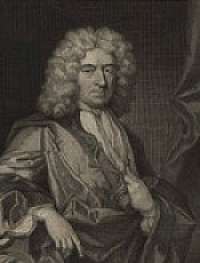
Western Daily Press, 9 March 1894
A preliminary meeting was held yesterday, in the Guildhall, in support of the movement for erecting statue of Bristol's great philanthropist, Edward Colston. It will recollected that at the Colston Fraternal Society dinner J. W. Arrowsmitb. as president the Anchor Society, made the suggestion that the Colston Commemoration Societies should unite in erecting such a statue, and few days later Sir Michael Hicks-Beach, in his capacity as president the Dolphin Society, expressed a hope that the suggestion would taken and carried through to a successiul issue. We understand that the object yesterday's meeting was the formation a committee, representative of the Anchor, Dolphin, Grateful, Parent and other Colston commemoration societies, for purpose of raising the necessary funds...[It is] intended, we believe, to ask the Council to allow the statue to be placed on the site above St. Augustine's Bridge, to form a companion to that of Edward Burke, whioh has been given to the city by Sir W.H. Wills.
Western Daily Press, 17 October 1894
[A sketch of] the model prepared by Mr John Cassidy, the artists who has received the order for the work ... the features denote deep thought, the face resting on the left hand; the elbow of the left hand being supported by the right hand, which in turn is suppprted by a long walking stick.
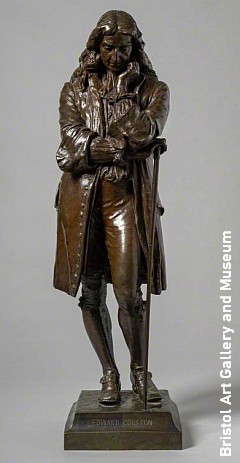
A small bronze (67 cm high) was also made, and is now in the care of Bristol Art Gallery, bequeathed in 1913 by J.W. Arrowsmith.
Creation
A competition was organised for the best design; out of 32 entries, Cassidy's won the approval of the Committee.
The public statues in Aberdeen and Belfast also date from that decade; in later years, al least until the war memorial era, he ceased to enter such competitions, accepting commissions mostly from north west England.
The bronze casting from Cassidy's models was done by the Coalbrookdale Company.
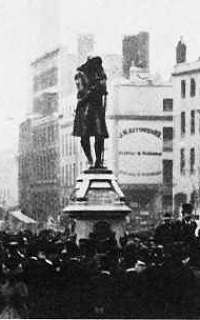
The statue was unveiled by the Mayor of Bristol, Mr W.H. Davies, on 13 November 1895; the picture above shows the crowds gathered for the event.
From the statues page at about-bristol.co.uk:
'Subscriptions for the statue were not sufficient and the remaining balance was contributed by an "anonymous gentleman".
'Bronze dolphins decorate the corners of the statue's plinth. According to legend, Edward Colston took the dolphin as a symbol following the safe return of an uninsured vessel. The ship was in danger of sinking due to a large hole, which a young dolphin plugged with its body.'
The same story inspired the name of the Dolphin Society, whose symbol, not looking much like a dolphin, is clearly the inspiration for Cassidy's bronze beasts. The society was founded in 1749 by 18 gentlemen members of the Colston Society who commemorated Edward Colston’s birthday by dining at the Cock Tavern in Corn Street, when they made a charitable collection for the poor. Ever since, it has launched an annual charity appeal.
Colston's life
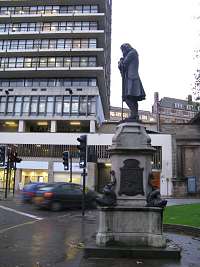
Edward Colston was born on 2 November 1636 in Temple Street, Bristol, the eldest son of William Colston (1608–1681), a merchant, and his wife, Sarah, née Batten (d. 1701). A royalist and an alderman, William Colston was removed from his office in 1645, during the English Civil War, after Prince Rupert surrendered the city of Bristol to the Parliamentary forces.
The family moved to London, where Edward grew up to become a prosperous merchant: as the Dictionary of National Biography puts it, 'Much of his wealth is thought to have been made in buying and selling slaves.'
From the 1680s he took an interest in his native city, although his main home remained at Mortlake near London.
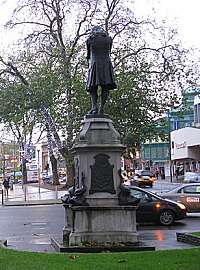
In the 1690s he founded and endowed almshouses in Bristol. He also endowed Queen Elizabeth's Hospital, a school for boys, and was instrumental in helping the Merchant Venturers to found Colston's Boys' School, which opened in 1710. Two years later he donated money for a school in Temple parish to educate and clothe forty poor boys. He gave money to other charity schools in the city and paid for the embellishment of several of the city's churches, including the Cathedral.
Colston, who never married, was a strong Tory and high-churchman, and an opponent of Catholicism, dissent, and Whigism.
In October 1710 he was returned as MP for Bristol, but he took little part in the work of parliament.
He died on 11 October 1721 at his home in Mortlake, and his body was carried in a hearse from London to Bristol for burial on 27 October amid 'much pomp and ceremony' at All Saints' Church.
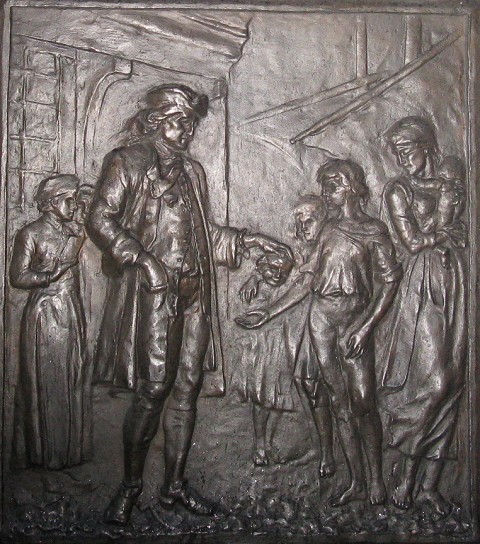
Colston distributing alms to the poor.
He became something of a hero among the city's business community: his memory was celebrated for many years by several societies, including the Dolphin Society, set up by the Tories in 1749; and by the Anchor Society, founded by the Whigs in 1769. The anchor and dolphin are duly prominent on the statue.
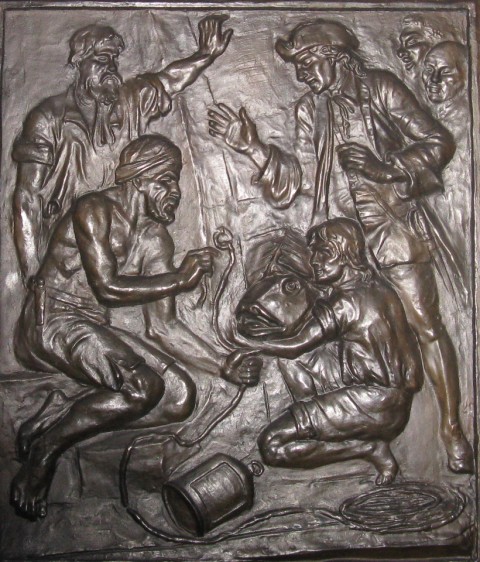
The unfortunate dolphin in the process of saving the ship.
Celebrating Colston's memory was part of the civic ritual of Georgian Bristol, the anniversary of his birth becoming virtually a public holiday after the 1720s. Colston's Day is still commemorated every 13 November by the Bristol schools and charities founded in his name. Presumably 13 November is used as the equivalent to his birth date, 2 November 1636, after the English calendar was moved on 11 days to match the Gregorian calendar in 1752.
His name appears on several streets in Bristol. Opposite the statue site is an office block once called called 'Colston Tower' The well-known concert hall 'Colston Hall' is now 'Bristol Beacon'. But it's going take long time to eradicate the many other names in Bristol, as this list shows.
Edward Colston statue, Bristol (1895)
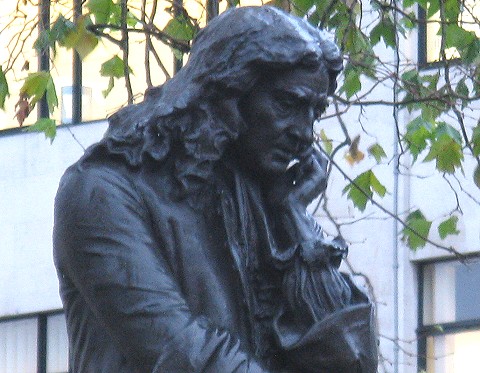
Visiting Bristol in December 2009, we asked at a tourist information desk for advice on locating the statue. 'At the end of the city centre', the lady replied, drawing an X on a map for us. 'He looks like he's making a mobile phone call.' And so he did!
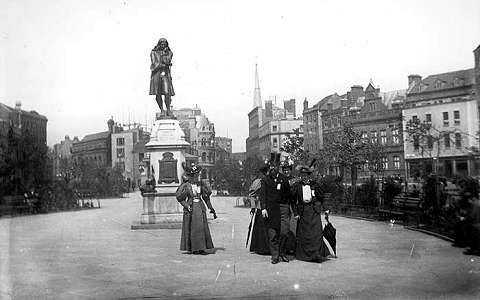
This old picture shows the statue in a pleasant wide-open space ...
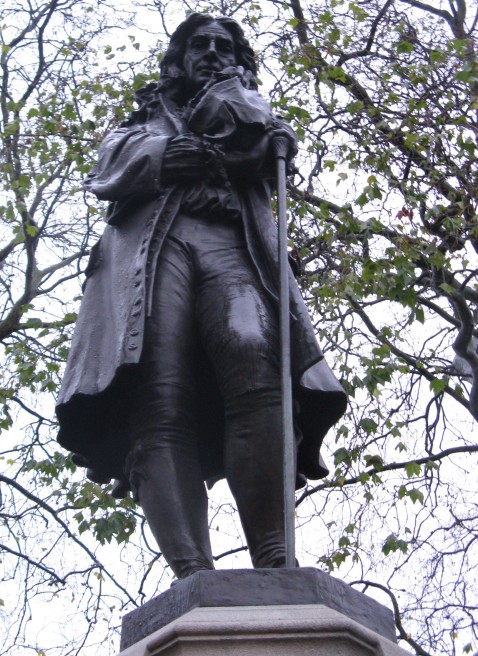
... but in 2009 a face-on view was quite difficult to obtain as a busy road ran across where the people are promenading in the old view.
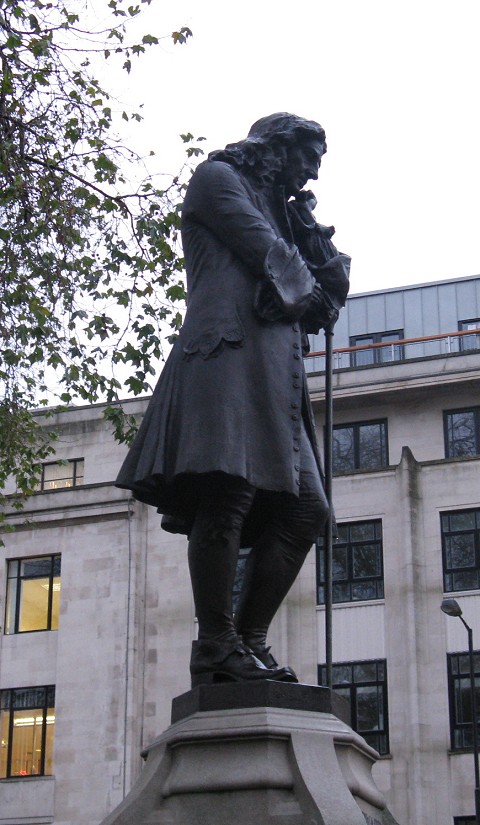
The bronze statue was, although slightly larger that life-size, rather dwarfed by its surroundings. According to contemporary reports it is eight feet eight inches tall, and the pedestal ten feet high.
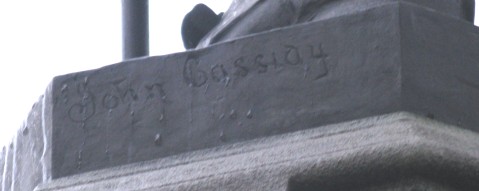
Cassidy's signature on the base.
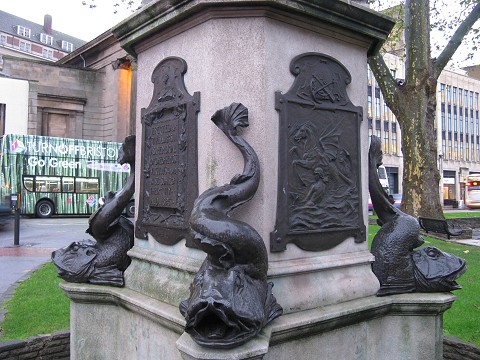
The various bronze items around the plinth. On the four corners 'dolphins' - vaguely resembling the one on the Manchester Jubilee Fountain which was unveiled a couple of years later. (See the dolphin story in the left column.)
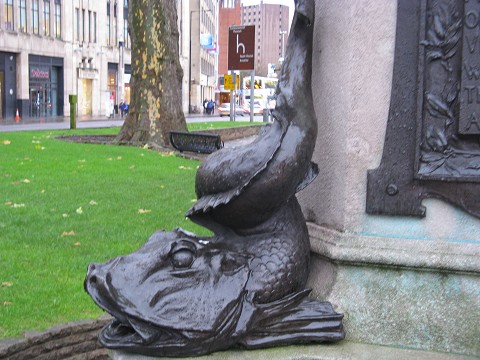
On the faces of the plinth, bronze plaques: the one on the front with the inscription:
ERECTED
BY CITIZENS OF BRISTOL AS MEMORIAL TO ONE OF THE MOST
VIRTUOUS AND WISE SONS OF THEIR CITY A.D.1895
and signed at the bottom 'JOHN CASSIDY FECIT.' On the other three sides, scenes rendered in relief, with no explanation of their meaning.
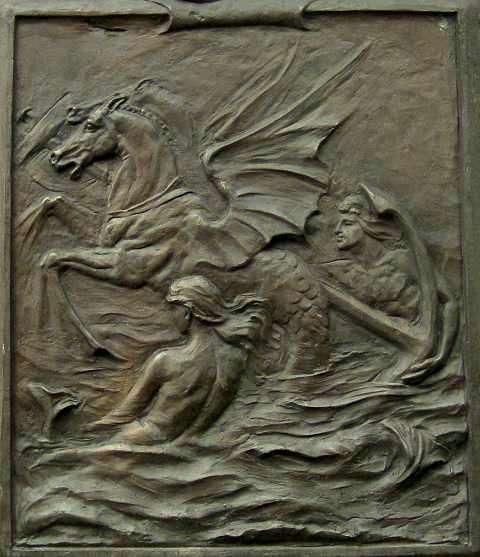
And some mermaids lifting an anchor with the help of a flying merhorse.
Destruction? The events of June 2020
On 7 June 2020, during 'Black Lives Matter' protests sparked by the killing of a black man, George Floyd, by a policeman in the USA, this work looked about to join the ranks of 'lost or destroyed' works when it was pulled down and pushed into the water of the 'floating docks'.
The statue had been at the centre of controversy for some years before this, as Colston made his fortune in the slave trade, which could never be excused by his philanthropic acts. Arguably it should have been moved to a museum years ago; the Mayor of Bristol in 2020, himself of Jamaican heritage, indicated after the incident that it would be recovered and placed in a museum, hopefully with detailed interpretation.
It's interesting that Cassidy modelled his face with an worried expression, rarely seen on other works of this nature. What was he thinking?
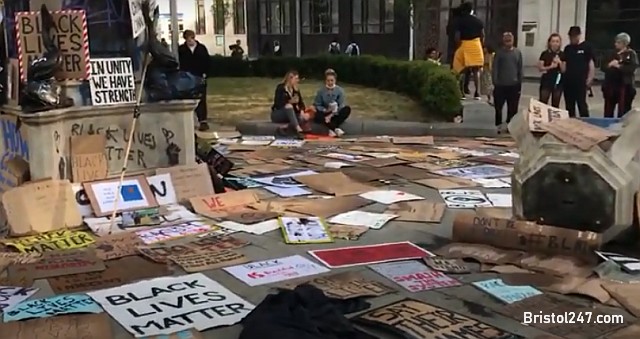
The scene on 8 June 2020.
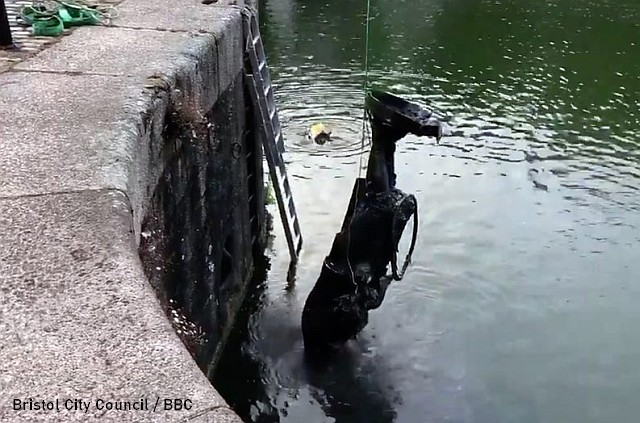
Recovering by the Council, early in the morning of 11 June 2020. There was a distinct risk that someone trying to view it would fall in to the water.
2025 Update
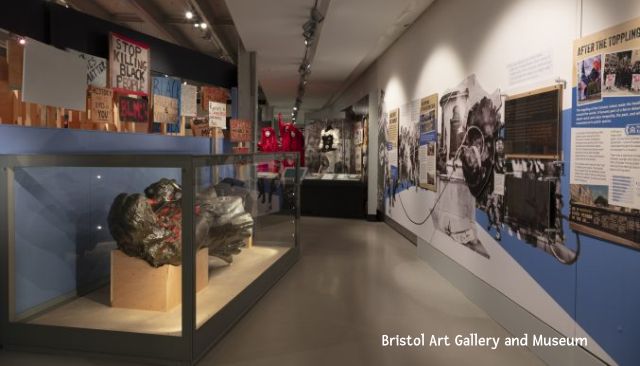
Since 2014 the statue, lying horizontal, has become part of a display in the 'M Shed', a part of Bristol Museums situated on the harbourside. The display tells the history of protest in Bristol, with the permanent inclusion of the statue of slave trader Edward Colston. Full information can be found on the museum website.
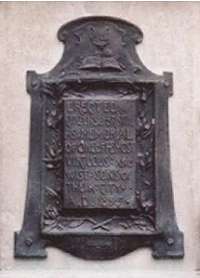
This picture of the Colston plaque was taken for inclusion in the original version of this page by the late Dr Roy Tyldesey, (1921 - 2005) uncle of Lis Nicolson. This page is dedicated to his memory.
Links and references
Colston's Day at Bristol. The Times, Thursday, Nov 14, 1895; page 10.
Edward Colston in the BBC 'Business of Slavery' gallery.
Colston in Wikipedia
Protestors topple statue of Slave Trader. The Guardian, 7 June 2020.
Lydia Figes. Pushed off the pedestal: who was the slave trader Edward Colston? Art.uk website.
Compiled by Charlie Hulme. Last update 2021
Comments welcome at Johncassidy@nwrail.org.uk